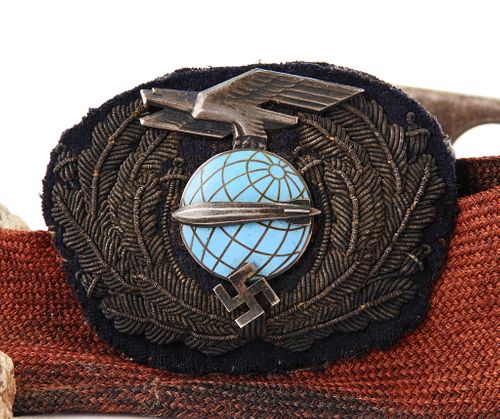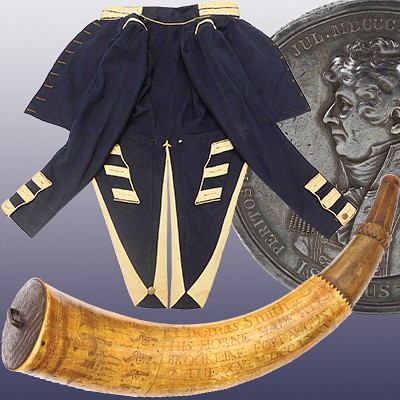Hindenburg Disaster Officer's Cap Badge and Relics
About Seller
63 Fourth Avenue
Cranston, RI 02910
United States
Kevin Bruneau is an antiques aficionado having professionally been involved with antiques since 1992. Being a staple character in the east coast antiques circuit, Kevin originally owned and operated two antique stores from 1992 to 2002. He than elevated his business practice having co-owned and mana...Read more
Two ways to bid:
- Leave a max absentee bid and the platform will bid on your behalf up to your maximum bid during the live auction.
- Bid live during the auction and your bids will be submitted real-time to the auctioneer.
Bid Increments
| Price | Bid Increment |
|---|---|
| $0 | $25 |
| $500 | $50 |
| $1,000 | $100 |
| $2,000 | $250 |
| $5,000 | $500 |
| $10,000 | $1,000 |
| $100,000 | $2,000 |
About Auction
Nov 20, 2021
Bruneau & Co. Auctioneers is proud to announce our fall Historic Arms & Militaria auction featuring over 500 items for anyone from the beginning collector to advanced collections. Bruneau & Co. Auctioneers ashle@bruneauandco.com
- Lot Description
Germany
C. 1937
A zeppelin officer's cap badge with a silver eagle over a blue-enameled globe with a silver airship in the center, and swastika at the bottom mounted on an embroidered wreath, and sewn to a piece of worsted vertical ribbing, a piece of the superstructure of the Hindenburg, and two stones picked up at Lakehurst Naval Air Station. Note: Chief Petty Officer Thomas J. Evans, United States Coast Guard, was stationed at Ocean City N.J. when early on the morning of May 6th, 1937, a message from the Naval Air Station at Lakehurst requested men for active duty for when the Hindenburg arrived at the airbase. The mammoth German dirigible was scheduled to moor at 4pm. Due to a local storm the landing was postponed till 7pm. During this time the big zeppelin cruised to New York city and back. Shortly after 7pm the Hindenburg, with its mooring lines dangling over the sides, edged slowly toward the mooring mast. At 7:21 two explosions were heard and the Hindenburg erupted into flames. Chief Evans was standing directly underneath the ship as it fell toward the ground. As he ran, trying to escape the falling debris, another man bumped into him, sending him running the length of the ship. As he ran he could hear the tail section behind him crash to the ground. He sped up and his biggest fear at that moment occurred when part of the superstructure hit his heel taking him to his knee. As he pushed himself up off the ground he saw a smoldering shiny object directly below that he scooped up as he expected the ship to come crash down on him. Just to his side was the cockpit that saved his life long enough to pivot there as he dashed out from under the crashing ship. Without thought he pocketed his find and his work detail now became a search and rescue misson. Hours later he stepped off to the side to investigate what he risked his life to obtain. It was a cap insignia from one of the officers. He also acquired a small section of the Hindenburg superstructure and two small stones from the crash site. The first officer of the Hindenburg was Captain Albert Sammt. In his autobiography he left an account of what happened to him, including losing his cap insignia while trying to get away from the cockpit of the ship "Once I'd gotten the last of the flames put out, I opened first one eye, and then the other: I could see! Then I reached for my ears: they were still there too. Fortunately, my hat was still sitting on my head, although the insignia on the front had been torn off at some point during my escape. I had pulled my hat down tightly over my ears, which protected my eyes and ears - otherwise I would have been far more badly burned."
Chief Petty Officer Thomas J. Evans, United States Coast Guard, by descent to the consignor.All in good condition.Condition
- Shipping Info
-
Bruneau & Co. Auctioneers can provide a successful bidder with an in-house packing & shipping quote or with a list of shippers if preferred. The Company will not be responsible for the acts or omissions of carriers or packers engaged by the buyer whether or not such shipper was listed by the Company. Property will not be released to a third party shipper without the buyer’s consent, and unless the Company is in receipt of full payment. Any packing and handling by the Company is at the entire risk of the buyer and the Company bears no liability for any loss or damage to such items. The cost of shipment will be Buyer’s full responsibility.
-
- Payment & Auction Policies
-
Available payment options
-
-
- Buyer's Premium



 EUR
EUR CAD
CAD AUD
AUD GBP
GBP MXN
MXN HKD
HKD CNY
CNY MYR
MYR SEK
SEK SGD
SGD CHF
CHF THB
THB



























